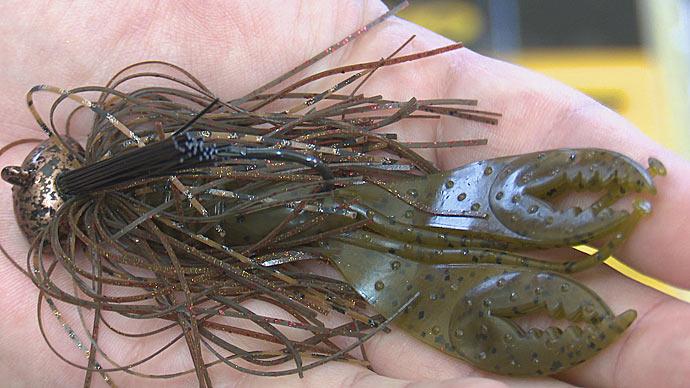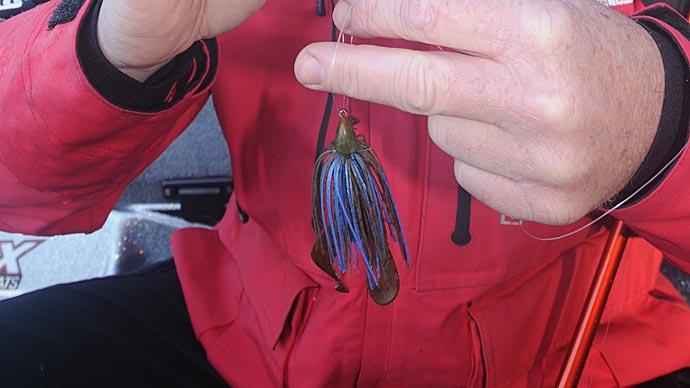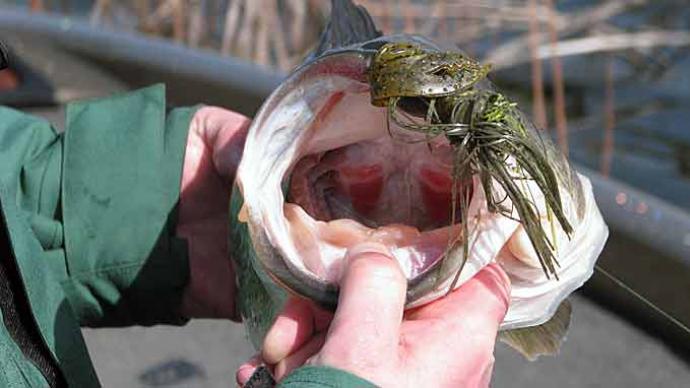
Out west, if you don’t know how to fish a one-tonner, you can’t call yourself a bass fisherman. A one-tonner is a one-ounce football head jig. You can cast one of these behemoths out on a shallow flat and crank it back, so it swims along and clips any rocks in its path, you can bounce it down a cliff or a rip-rap bank, you can flip it tight to the structure, or you can pitch it right up into the shade next to a rock. But one of the all-time most productive ways to fish these big baits is to drag and hop them around deep structure any time of year.
This is a perfect way to fish in cooler weather when the big boys aren’t up shallow yet and during pre-spawn when the big females are starting to stage on deeper structure near the spawning beds. You can vary your retrieve to fit the water temperature – big hops and quick drags in warmer water, slow twitches and little hops in the cold. Either way, the basic technique remains the same.
Once you’ve located a likely-looking spot, cast the jig out, hold the rod down and watch the line. You can throw a one-tonner a long way. Keep your eyes on the line because sometimes the bass will suck it in on the fall and keep coming at you, so all you’ll get is line movement. Use line you can see, and let it feed out from the reel until the jig hits bottom. You’ll know this has happened when the line goes slack. Many anglers mistake casting out a jig, turning the handle, and then watching the spot where the jig hits the water. You must let it get down to the bottom before turning the handle. If you turn the handle before the jig hits bottom, it will swing toward you, and you won’t be anywhere near where you wanted to fish it.
Start hopping it fast; then, if you’re not getting bit, start slowing down your presentation. A big one-tonner hits bottom hard and kicks up a lot of mud, like a crawdad. If you’ve seen a crawdad move, they propel themselves up and backward, with their claws facing a threat. (Smallmouth often whack a craw with their body to turn the claws, so if you get a good bump in smallmouth country, let your jig sit there for a second to see if it gets picked up.) Hold your rod so that you can keep a finger and a thumb on the line.

When the jig hits bottom, turn the handle and give the jig a couple of small hops. With the line between your fingers, you can feel what is going on down there. You can tell when you are sliding over rocks or mud, and you can feel it when you run the jig into a big rock or a tree. You can feel it fall over the edge of even the most minor drop-off and feel the bites much better. One thing you need to be careful of is missing bites. If the line goes slack when it shouldn’t, if you feel a “tick,” if it feels like you are pulling on a rubber band – set the hook! Usually, if you wait for the second “tick,” that’s him spitting the jig back out.
If you drag your jig up to a tree or a rock, just work it slowly up to the top in small twitches. When it reaches the other side, it will start to drop. When that happens, give it some slack so it falls straight down instead of swinging away from the structure like a pendulum. If you hang up on a rock or something, just go back and get it. Nine times out of ten, a jig will just come loose easily if you go back past where it is snagged.
If the bottom is sloped toward you, try lifting the jig off the bottom with the rod tip, then following it back down. It will swing out, and since it is deeper now, you may not need to take up any line. You can lift and lower the rod slightly to keep a bit of tautness in the line. If the line is slack, you will miss a ton of bites. I find it easier to set the hook by swinging sideways instead of raising the rod, so I usually fish a jig standing up so I can turn and sweep instantly. You want to put some muscle in your hookset – there could be 60 feet of line between you and that bass, and you need to drive a sizable hook through a rigid jaw. Don’t be shy – give it all you’ve got.
If you haven’t decided on the perfect spot to fish, don’t worry -- one-ounce jigs make great search baits, too. You can pull up on the spot, throw a jig out, give it a couple of shakes, then try again. If you don’t get bit, move on to the next spot. When a big bass takes a jig, the weight often goes away. One minute you’re bouncing a chunk of lead, and the next minute it feels like somebody cut your line. When that happens, set the hook – hard. If the fishing is tough, try this trick: when you work the jig back to the boat, don’t reel it up immediately. Move it around a little by using the trolling motor.
GEAR
You need a big stout reel with at least a 7.1:1 gear ratio for fishing big jigs. A fish on a jig will head right toward you, and you need to beat him to the top. Let him get on top and start shaking his head, and that lead gives him a lot of leverage and makes it pretty easy for him to throw the hook. So, by all means, get him to the boat quickly, and keep him down. A rod with plenty of backbone and a fast tip is perfect for jigs. I use a Phenix Boron jig and pig rod that I’ve had for over 20 years, paired with an Abu Garcia 4600C4 reel. I love that the rod has a big comfortable bulb in front of the reel because I hold the rod with my left hand on that knob and the handle under my arm against my side. I keep my finger and thumb on the line to feel little ticks or slackness.

You’ll probably want an assortment of jigs in different weights. The big “One-Tonner” 1-ounce football heads are dynamite for deep water and crashing around on rocks. They are also great for dragging around in the mud; if the wind is a problem, a one-tonner isn’t affected as much as some baits are. Big jigs are also deadly accurate for pitching and flipping. If the fish are slow, you may need to downsize a bit. A lighter jig will have a slower fall and may stay in the strike zone long enough for a sleepy winter bass to take an interest. I like Yamamoto jigs because I use Yamamoto grubs and baits almost exclusively. The Yamamoto jigs have a double ring instead of barbs to hold the baits. Their baits are soft, and barbs rip them.
Yamamoto used to sell twin-tail grubs, and I still have a bunch. And no, you can’t have them. If you want twin tails, you’ll do fine with the Yamamoto Hula Grub. I like being able to use two different colors. You can still get several colors of Hula Skirts, and if you want to mix and match, you can cut the skirts off the Hula Grubs and add a separate skirt. Save the original skirt and add it to a small grub when you’re fishing slow and want a light jig to fall even lower. If you can catch a crawdad where you’re fishing, use it to match the bait to the prey. Tip: catch a fish and look down his throat. A lot of times, you can see what he’s been eating. Or put him in the livewell for a bit, then look to see if he’s upchucked anything interesting. You’ll probably find that you can get along just fine with a couple of baitfish colors and a couple of crawdad colors.
My favorite Yamamoto craw colors are watermelon with black and red (208), watermelon with black only (194), pumpkin orange with green and black (196), and cinnamon with black and purple flecks (221). For shad colors, it’s hard to beat smoke with black, blue, and chartreuse (214). I also love the natural shad (306) and the smoke with black and holo flecks (238).
Scent: even if it doesn’t attract bass, it surely helps cover the smell of humans and plastic, so it’s a good idea to use scent fairly religiously. There are all kinds – sprays, gels, dips – choose whatever trips your trigger. I like Yum. If you fish out here in the desert, don’t choose a canned spray. The heat trashes them, the button can get stuck, and you spray crawdad-scented oil all over yourself and the boat. I’m not saying that this has ever happened to me, but…
Line: You need to see what your line is doing. You have to know when the jig has hit bottom, and if a fish takes it on the way down, you need to see that line moving off sideways. I have used Berkley Vanish Transition clear gold fluorocarbon line for years. It glows gold above the water but is clear when it gets wet and sinks well. I love the stuff. I use a mono that glows in black light when fishing jigs at night. Either way, 17-pound-test is the way to go. You’re going to be putting a lot of stress on that line when you set the hook on a big bruiser, plus you’re going to be dragging that knot all over the rocks and trees down there.




